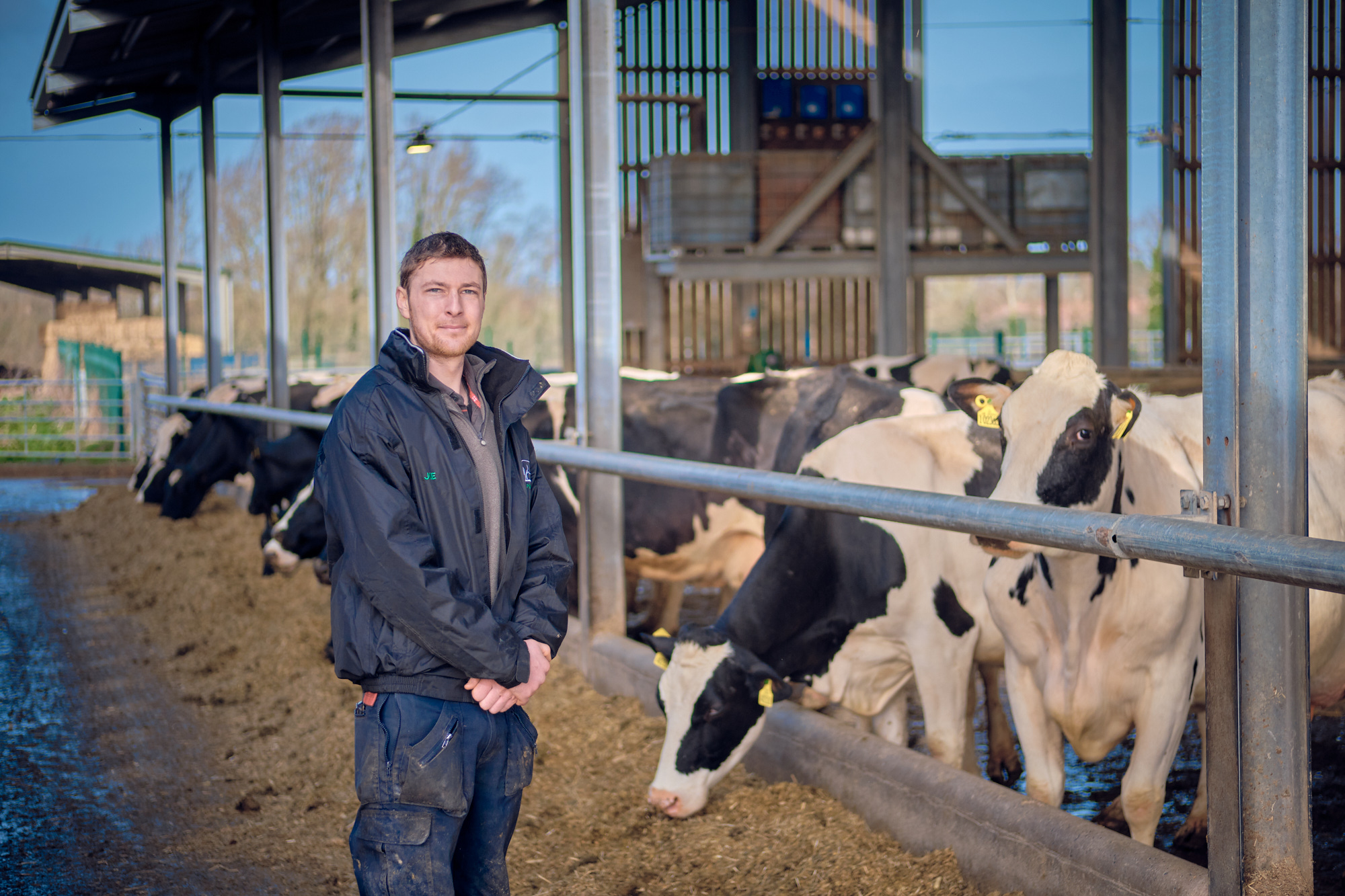Driving performance over a lifetime
Friday, 19 March 2021
Joe Carter's Holstein herd achieves an impressive daily lifetime yield of 20.4 litres at Carpenters Farm, our strategic dairy farm, in Wiltshire.
Lactation yields or daily ‘per cow’ yield are the favoured measures of production in all-year-round calving herds. Yet this risks overlooking other areas such as fertility, timely first calving and length of life which are all important when weighing up overall productivity and managing costs.
Joe and his family farm 300 Holsteins in a housed system close to Chippenham, Wiltshire. The cows are housed in two groups and calve throughout the year with an emphasis placed on a high welfare environment with minimal hard group transitions.
With consistent production figures of 10,500 litres/cow, a calving interval of 384 days and a pregnancy rate of 24.3%, Joe is already hitting good numbers.
Looking at all animals who left the herd in the last 12 months, he’s achieving a daily lifetime yield of 20.4 litres, placing him in the top 5% of producers across GB and almost twice the average of 12.8 litres.
Review Carpenters Farm key performance figures
Focusing on cow comfort and stress reduction together with running a separate heifer lactation group are helping to maximise the genetic potential of Joe’s cows. He regularly assesses the conditions in the buildings and monitors cow fertility and yields.
“I have worked closely with my nutritionist, Roy Eastlake of Lallemand, to create a low-stress and comfortable environment for my cows. Offering deep sand beds, lunging space within cubicles and loafing areas,” says Joe.
“Roy and I regularly discuss how we can maximise feed space and how we can ensure they are lying down and ruminating for the maximum amount of time – I don’t want cows to wait for anything. Feed space is around 60cm per animal but I would prefer to increase this particularly for fresh cows and no cow should be away from her barn for longer than 1hr for each milking.”
Joe has split the milking herd into two groups: heifers and subordinate cows are in the older buildings, to minimise bullying from mature cows; and the main group, housed in a new building erected in 2015.
There are far less accidents caused by bulling cows and it helps Joe to get the cubicle dimensions correct for the consistently-sized cows in each group. Cows are fed a flat-rate TMR regardless of their lactation stage, to minimise some of the health and metabolic challenges of regular diet changes.
A policy of culling animals not in calf by 200 days has reduced the number of fat cows and the associated calving difficulties that lead to poor fertility. The LDA rate last year was 1.5% and was put down to a dryer than expected batch of maize in the maize/straw-based ‘Goldilocks’ transition diet.
During transition, stable groups of 12 cows are housed in separate sheds. They are fed together, calve together, and are reintegrated as fresh cows back into the herd in small groups. The group dynamic never changes to minimise stress. It also allows for a full muck out and deep clean between groups. Transition intakes ‘for the close to calving cows’ are 13.1kgDM/day.
Listen to our podcast about success in transition
Average age at first calving is 23.8 months, which is achieved through a combination of weighing calves regularly and working with a trusted heifer rearer. The targeted age of first service of 12 months.
The farm had experienced a lack of weight gain in calves, which was put down to the scouring at around seven to ten days old. Calf health has since improved with changes such as switching from five bar feeders to individual compartments, ensuring every calf receives enough milk. Feeding good quality colostrum quickly via a bottle and teat with less reliance on tube feeding, which had previously caused throat soreness, has lifted calf health.
Calf management guides and resources
When maiden heifers are served and confirmed ‘in calf’ they are housed in cubicles next to the subordinate group. This helps to train them to cubicles, allows them to ‘meet’ their future peers – minimising the stress when they calve and introduces them to their new accommodation. Also, in calf heifers are run through the parlour twice per week before feeding to get them used to their new role so they associate it as a positive experience.
On the back of good fertility scores - pregnancy rate of 24.3% with a voluntary waiting period of 42 days and a calving interval of 384 days - Joe is now using solely sexed and beef semen on all cows and heifers. Sexed is used primarily for maiden and 1st lactation animals to maximise genetic gain and used for 2-3 services with everything else being served to British Blue semen. Heifers are not served past 16 months old.
“We had been chasing cow numbers for the last few years due to TB meaning we had been more lenient on our cull decisions,” Joe explains. “We are in a good position now with lots of heifers coming through so we have a strict policy on fertility. I have been working on breeding for fertility and health traits and am keen to push this as we move forward, making sure that every cow place is filled with a productive, efficient cow – a cow that is not extreme, gets in calf, meets or slightly exceeds the herd yield average.”
Find out more about Carpenters Farm


